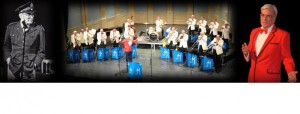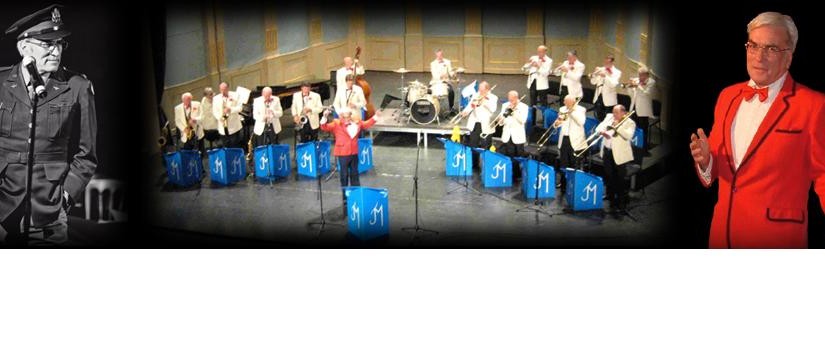Rye Town Band 1957
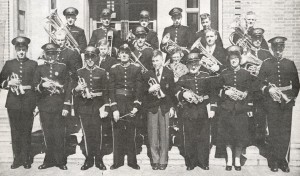
Back in the 1950’s on Tilling Green Estate, Rye the quiet summer evening was often shattered by the piercing sound of a trumpet as 13 year old Robert Cutting practised his scales. Robert was a very young member of Rye Town Band, along with his father, … who had introduced him to music at a very young age. None of those that heard the teenager practising in those far off times would have had any idea that his name would, one day, be connected to that of the legendary Glenn Miller.
GLENN MILLER
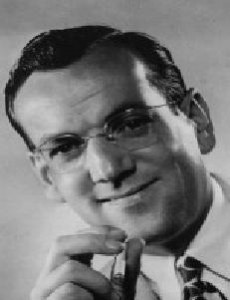
Glenn Miller first saw the light of day in Clarinda, Iowa on March 1, 1904.
Several years later, after the family moved to North Platte, Nebraska, Glenn’s father brought him a mandolin. Glenn got his first practical taste for making music but soon traded strings for brass and acquired an old battered trombone, which he practised at every opportunity. In 1923, the music mad 19 year old enrolled at the University of Colorado, but time taken out to attend auditions and playing at each and every engagement that came his way, resulted in him dropping out of Uni and concentrating on his chosen career as a professional musician.
After touring with a couple of orchestras he ended up in Los Angeles where he met Ben Pollack and joined his band of musicians which included the one and only Benny Goodman. Glenn Miller wrote some arrangements for Pollack. It was arranging that was to serve him so well in the years ahead.
Glenn married Helen Burger in 1928, and worked as a free-lance trombonist and arranger. By 1931 he was playing and arranging for the likes of Tommy and Jimmy Dorsey (who on several of their records, Gene Krupa, Eddie Condon and Coleman Hawkins. 1934 saw Miller become the musical director of the Dorsey Band. He later went on to direct The Ray Noble Orchestra, which included Charlie Spivak, Peewee Erwin, Bud Freeman, Johnny Mince, George Van Eps and Delmar Kaplan among its ranks.
By 1935 Miller was recording under his own name for Columbia. His instrumental ‘Solo Hop’ reached the Top
10 but ‘Moonlight on the Ganges’ and ‘A Blues Serenade’ for Columbia were unsuccessful.
Glenn organized his own touring band in 1937 and signed up with Brunswick records. There were a couple of recordings, two week-long stints in New Orleans and Dallas, and numerous one-nighters, but it was not to be. Glenn was forced to give his band their final notice on New Year’s Eve at the Valencia Ballroom in York, Pennsylvania. Broke, depressed and having no idea what he was going to do, he returned to New York City.
At this desperate period in his life he decided that if he were to try again he would have to come up with a new and individual sound that would stand out in this time of big bands and dance music. He reasoned that the sound produced by the clarinet holding the melodic line while the tenor sax plays the same note, supported harmonically by three other saxophones might well be a unique and easily recognizable style that could set his band apart from all others.
The second Glenn Miller Orchestra was formed in March 1938, it would later include Tex Beneke, Marion Hutton, Ray Eberle, Paul Tanner, Johnny Best, Hal McIntyre, and Al Klinck. It soon began breaking attendance records up and down the East Coast and at the New York State Fair in Syracuse the largest dancing crowd in the city’s history attended. The Orchestra was invited to perform at Carnegie Hall with Paul Whiteman, Fred Waring and Benny Goodman and Miller’s Orchestra was rated the best on the evening.
Record-breaking recordings such as ‘Tuxedo Junction’, which sold 115,000 copies in the first week, ‘In the Mood’, and ‘Pennsylvania six five thousand’ swept America. In all Miller had 31 Top Ten hits in 1939
By 1940, Down Beat Magazine had rated Miller Orchestra as ‘Top Band’ in its ‘Sweet Band Poll’. At this time Glenn’s ‘Moonlight Serenade’ radio series was going out three times a week on CBS.
In 1941, it Hollywood where the band worked on its first movie, ‘Sun Valley Serenade’, which included ‘Chattanooga Choo Choo’ the first Miller million seller. By this time the war was taking its toll on many of the big bands as musicians, and the rest of country’s young men, began receiving draft notices. Glenn was too old to be drafted but was very patriotic and volunteered. The end of Miller’s dominance of popular music came when he received an officer’s commission in the Army/AirForce.
On 7 October 1942, Glenn Miller was assigned to the Army Specialist Corps. His appointment was as a Captain to the army band. His training complete, he was transferred into the Army Air Corps, where he ultimately organized the Glenn Miller Army Air Force Band. Miller’s goal of entertaining the fighting troops took another year to be realized, but in late 1943 he and the band were shipped out to England. For the next year, the Glenn Miller Army Air Force Band engaged in over 800 performances. Of these, 500 were broadcasts heard by millions. There were more than 300 personal appearances including concerts and dances, with a gross attendance of over 600,000. But Glenn was not to participate in the final six months of these activities.
In the autumn of 1944, the band was scheduled to be sent on a six-week tour of Europe and would be stationed in Paris during that time. Miller decided to go ahead, in order to make the proper arrangements for the group’s arrival. And so, on December 15th, Glenn Miller boarded a transport plane to Paris, never to be seen again.
“A band ought to have a sound all of its own. It ought to have a personality.” – Glenn Miller
HERB MILLER
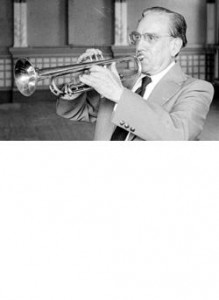
Herb Miller developed his musical talent very much under the guidance of his elder brother Glenn, and went on to form various bands in America. Herb’s budding career was cut short by a stint in the Army at Fort Ord California where, after his discharge, he settled in Pacific Grove on the Southern tip of the Monterey Bay. There, to great acclaim, he taught music in several schools and, being a practical man, personally built a house big enough to rehearse a big band in and, probably secondarily, raise his four children. Music was always the main driving force, focal point and ultimate aim of Herb Miller.
Many years after the disappearance of Glenn, Herb was given the opportunity and decided he wanted to recreate the Miller Magic and form an orchestra to play the music of his brother. Herb had worked in America for many years with his son John. John started playing bass with his father’s band at the tender age of 15 and shortly thereafter, in addition, became the band’s singer. Nepotism was alive and well in the Miller family. Herb’s oldest daughter came into the band on piano, his youngest son, in time, joined the trumpet section and the baby of the family, Janet, started singing at Twelve.
JOHN MILLER
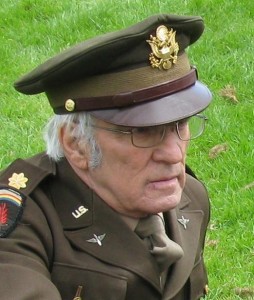
The John Miller Orchestra – formerly The Herb Miller Orchestra – is the only Big Band performing the music of Glenn Miller with direct family links to the great man himself, in the form of John Miller, his nephew. In the Miller family, there were three brothers and a sister. In order of appearance they were Dean, Glenn, Herb and Irene. Herb was John’s father which makes Glenn, John’s uncle.
When they decided to form the Herb Miller Orchestra in Great Britain John became his business partner, and the featured singer with the band. John and Herb built an organisation which now contains some of the best musicians in the country. There are still two of the original members that have been with the band for 34 years and the rest range in service time from 30 years down to 12 years with the odd “newcomer” with only 4 or 5 years on the roster.
ROBERT CUTTING
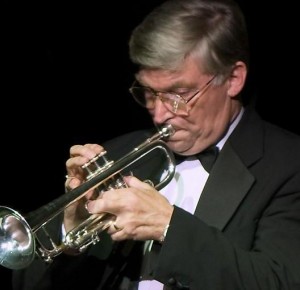
Robert “Bob” Cutting has come a long way since those years playing a trumpet in Rye Town Band with his dad Ray and his wife to be Margaret Curtis. He is now the lead trumpet in the famous John Miller Orchestra and has played with the famous ‘big band’ for over 30 years, Bob Cutting started his career in the world of brass bands and joined the 3rd Dragoon Guards Band, training at the famous Royal Military School of Music (Kneller Hall) in 1960-61. Leaving the Army in 1964 he worked in photography and joined the well-known “Morris Motors Brass Band” working under such notables as Sir Harry Mortimer, Sir Malcolm Sargent, Imogen Holst and many other eminent conductors of the time. Leaving behind the world of brass bands in 1972, Bob joined the Eddie Curtis Orchestra. Working, recording and touring as lead trumpet/soloist with The John Miller Orchestra and before that the Herb Miller Orchestra. This was the beginning of a professional career in performing and teaching in most genres of music, and has been the mainstay of his musical career. There have been other notable freelance ventures with various bands and shows – Swings the Thing, Debbie Curtis Radio Big Band, The Joe Loss Orchestra, The Ray McVay Orchestra and The Glenn Miller UK band being a few to note. Teaching has seen him as a peripatetic brass teacher at St Edwards School (Oxford), Oxford High School, St Helens and St Katharine’s School (Abingdon), Moulsford Prep School and many others, plus a busy teaching practice of his own. Taking on the role of Musical Director of the Harold Elmey Big Band is his latest venture in a busy, musical life. Robert’s formative years were spent in his birthplace, Rye , East Sussex and he was educated and spent his childhood and teens in a place which is still very dear to his heart. He played in the Miller band this year at the War & Peace Revival at Hythe. Some of his old Rye school-mates and friends were present for the ‘showcase’ entertainment event on the Saturday evening. Such is the popularity of the John Miller Orchestra and the amazing Glenn Miller sound, the show was ‘sold out’ days before and many were disappointed. Robert Cutting hopes that one day the band will be invited to perform in his home town, there would be little difficulty selling tickets there either.
